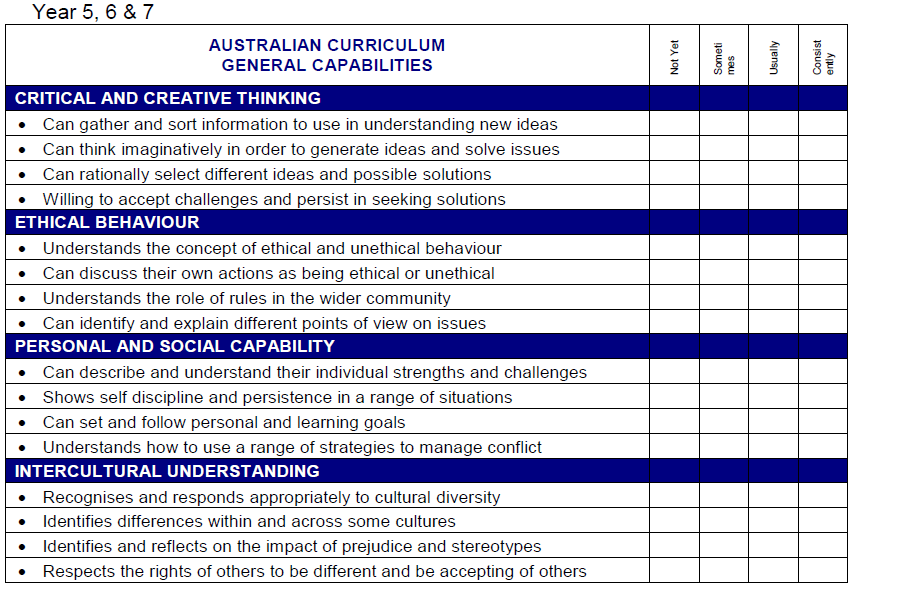Introduction
The Primary Matters newsletter, prepared by the ACARA Curriculum team, highlights news and updates on projects relating to primary education in Australia.
Three dimensions of Australian Curriculum
In this edition, we highlight the three dimensions of the Australian Curriculum – learning areas, general capabilities and cross-curriculum priorities. ACARA continues to provide illustrations of practice and resources demonstrating how schools use the dimensions as they implement the Australian Curriculum.
 Sue Toone is the Principal of West Lakes Shore School in South Australia. In this article, she shares her school’s journey in embedding the general capabilities within the learning areas in a primary school setting.
Sue Toone is the Principal of West Lakes Shore School in South Australia. In this article, she shares her school’s journey in embedding the general capabilities within the learning areas in a primary school setting.
As a school leader in South Australia, I have seen the emergence, implementation and eventual replacement of several initiatives attempting to bring a national consistency to curriculum across Australia. All of these had their strong points and were appropriate for their time. The Australian Curriculum, which emerged from the Melbourne Declaration in 2008, has been the most comprehensive and widely adopted of any of these attempts to nationalise the curriculum.
When the Australian Curriculum was first introduced, schools were made aware of the three different dimensions: learning areas, general capabilities and cross-curriculum priorities.
However, my experience in schools has been that teachers typically tended to deconstruct minutely the details within the learning areas, discovering the content descriptors and elaborations and, to some degree, the achievement standards and the year level descriptors. As more learning areas were released, the teachers repeated this pattern. As teachers gained confidence in understanding the content of the year level most relevant to their teaching, they began to compare these with the year levels above and below their own. They developed their own understanding of a scope and sequence of each learning area’s content.
As the need to report against the achievement standards became important, teachers began to look more closely at these, connecting them to the content and taking note of the verbs and nouns that described a hierarchy of skills and knowledge. Again, teachers looked at the standards on either side of the level at which they were reporting to deepen their understanding of expectations. Work samples in the online portfolios supported the development of more refined judgements, particularly as more and more samples appeared in this space. Staff in larger schools, and those in settings with close connections across school networks or neighbourhoods collaborated in moderating exercises to help build a valid, shared understanding of the standard and to install some confidence in the consistency of standards.
In all of this very important and valid familiarisation and then implementation of the Australian Curriculum, it seemed to me that several potentially empowering aspects were neglected, not due to lack of interest so much as lack of time and energy.
The first of these was lack of time and supporting resources to help teachers, particularly those in primary schools, to explore the links between the big ideas and the more detailed skills and understandings that would support integrated learning across learning areas. Generally, learning areas have been viewed in isolation, an approach that may not be surprising given their gradual roll-out over recent years. If we believe that the most engaging learning needs to be connected and personalised, then this containment of learning within each learning area has not been supportive of either of these pedagogical approaches.
The second casualty of the focus on isolated learning areas has been deep engagement with the general capabilities and cross-curriculum priorities. Whilst these have been acknowledged as important, they are embedded within the content descriptors, and teachers may or may not have an understanding of the symbols or icons that indicate their presence within a descriptor. In my experience, bringing these to light by supporting teachers to examine each individually helps to value the obvious effort that went into their development.
In many cases, there is a conflict with the considerable number of commercial programs that purport to deliver social and behavioural improvement in students and the creation of better school climates/cultures for learning. Some have focused on improving students thinking, global or 21st century learning capacities, and others, on cultural or environmental understanding and empathy. Over the years, these programs have filled a need and many have been highly effective when delivered or implemented intensively to script. They also have come with a range of costs and levels of commitment to support their success. School leaders and teachers have developed brand loyalty and put trust in a broad range of these programs and some are extremely passionate in advocating for some of these programs.
Many of them also fill a gap in the pedagogical space. However, in South Australia we are fortunate to have the well-researched and developed Teaching for Effective Learning Framework as the mandated pedagogical approach. Engaging with the general capabilities and cross-curriculum priorities does not mean letting go completely of these programs, but rather repositioning them as a resource that can support more effective implementation.
Bringing together learning
In working with two schools in South Australia through the familiarisation and implementation stage of the Australian Curriculum, I have led these school communities in adopting a slightly different approach to the implementation of the Australian Curriculum. This approach has centred upon finding connections between the skills and understandings, while linking some of the knowledge across many of the learning areas around a central set of big ideas and an overarching title. This has brought together the learning, not just across similar year levels but across Foundation – Year 7. It has also allowed for the conscious linkage of the learning program for each term with significant local or global events, and was supported whole-school participation in incursions and excursions, the use of inquiry questions and cross-class co-construction of learning.
This model of connecting curriculum has proven popular with students, staff and community, and has been effective in stimulating effective collaboration between teachers and students at many levels. It is distinctive from a thematic approach in that it consciously maintains the rigour of each of the learning areas. It clearly empowers the learning through connections and does not lose the integrity of the individual subject.
This has also brought the general capabilities and the cross-curriculum priorities to the forefront by explicitly identifying one or more of these for focus within each module of Connected Curriculum and identifying the opportunities within the learning program for active engagement with these dimensions of the curriculum.These specific identification and planning to support the development of the general capabilities and the cross-curriculum priorities have focused on what I would refer to as ‘less central capabilities’.
Literacy, numeracy and ICT have very prominent positions in the core work of every leader and school, and there are many datasets and standardised tests that allow teachers to understand and plan the learning in these areas. Teachers are confident in talking and reporting literacy and numeracy to communities, and ICT has an increasingly high profile, especially with the advent of the national STEM strategy.
However, Critical and Creative Thinking, Personal and Social Capability, Ethical Understanding and Intercultural Understanding are, in some places, the poor cousins. Not because teachers do not value the intent of these but they may approach their development in a haphazard manner, or they rely on one of the commercial products to produce the results they desire, or they trust that their embedding within the content descriptors will blossom into real learning.
Results at our school
The prominence given to the general capabilities in the design of the learning has also transferred into reporting. Many schools include a report on the social skills of their students, or their abilities to demonstrate the school’s values when reporting to parents. At West Lakes Shore School, we have replaced this aspect of reporting with a report against four of the general capabilities, using the learning continua. This continua gives descriptions of skill development typically expected of students at two-year intervals.
Teachers have agreed on some common descriptors of the skills within the general capabilities for inclusion in student reports to parents and have made judgements about students’ abilities or dispositions against these. These descriptors are adjusted between the year levels to reflect the increasing complexity of the capabilities.
An additional advantage is that it allows us to gather data over time about each student against the capabilities. For our school, this has identified areas for improvement and so, within the process of constructing the connected curriculum each year, we can build in a refocus or emphasis on some skills and abilities within the capabilities.
The data from the end of 2015 clearly reveal some areas of lesser achievement in the Critical and Creative Thinking that can be addressed by teachers in their future learning design.
This style of reporting relies on teacher professional judgement as well as the need to develop common assessment tasks that allow teachers to assess not just the content and the elements within a standard, but also to show up the student’s capabilities. Learning design, which focuses on a particular general capability, fits seamlessly with the content skills and understandings within learning areas, and is more likely to allow a teacher to plan for, and identify evidence of, the particular general capability.
While the moderation of teacher judgement against the capability learning continuum does not yet occur, the current emphasis on moderation against the achievement standards and the design of learning that allows all students to demonstrate their full abilities may lead to upskilling our teachers in this area of practice. The results will be better learning design through the inclusion of capabilities and more consistent understanding of the ‘typical‘ indicators in the learning continuum.
There is a growing awareness amongst educators that the general capabilities are well-developed and describe an overarching framework for the learning, which we all value highly and believe more important in the long-term development of successful life-long learners and citizens. I would encourage my colleagues to look at them closely and consider whether there might be a place within school improvement agendas for a greater commitment to the general capabilities.
Click on the images to view in full size
 Melinda Gindy is a mother of three children, two in primary school and the third in the second year of secondary school. Melinda is the President of the Gifted Families Support Group Inc. (NSW) and Vice-President of the Australian Association for the Education of the Gifted and Talented. Melissa is sharing with us her view on the Australian Curriculum.
Melinda Gindy is a mother of three children, two in primary school and the third in the second year of secondary school. Melinda is the President of the Gifted Families Support Group Inc. (NSW) and Vice-President of the Australian Association for the Education of the Gifted and Talented. Melissa is sharing with us her view on the Australian Curriculum.
What have been your experiences of the Australian Curriculum?
As a parent, I feel that the role families play in their children’s education, growth and wellbeing is essential. Throughout the development of the new Australian Curriculum, I have observed the importance of family being highlighted and implemented in practical ways, resulting in a positive, collaborative environment. Through the creation of a transparent national curriculum, I have been able to gauge an understanding of what my children will be learning at all stages throughout their educational journeys.
I have previously felt this information was unavailable on a public platform, whereas the rollout of the Australian Curriculum has incorporated parent information sessions and information flyers delivered by my children’s public and independent schools. Additionally, the extensive resource and support section of the Australian Curriculum website offers parents wealth of knowledge, also providing value and recognition of the integral role parents play. With this knowledge and information, I am hopeful to be able to support my children’s unique learning needs into the future.
I have been heartened to see that the Australian Curriculum is in line with the extensive supportive research on acceleration. A clear and concise curriculum has paved the way for measurable off-level testing, resulting in two of my children’s academic needs being met through both full-grade and single-subject acceleration. It has helped me to be confident: what my children will be learning is at just the right level and pace for their individual needs. From reading some of the work done by the Australian Council for Educational Research, I understand that in each year of school in Australia, the most advanced 10 per cent of students are five–six years ahead of the least advanced 10 per cent of students. As a parent of children who are thirsting for extension, I am optimistic that the Australian Curriculum is flexible enough to meet the needs of every child at their individual learning level.
What are the positives for you as a parent?
As a parent, I feel that the delivery of a curriculum structured on a continuum is essential to the unique learning needs of my children. I am thrilled that my children’s teachers have the ability, through the Australian Curriculum, to move around the continuum to ensure the children are indeed learning at school through a rigorous and engaging curriculum.
I believe that the increasing focus on the Australian Curriculum will deliver a national education that is in line with 21st century developments. The Australian Curriculum’s seven general capabilities give every teacher the means to support learners in exciting ways. The explicit incorporation of ICT reflects my children’s interests outside school and brings the home and school environments together.
I also value the delivery of a ‘whole-child curriculum’, so a focus on Critical and Creative Thinking, Personal and Social Capability, Ethical Understanding and Intercultural Understanding, as well as the Australian Curriculum’s cross-curriculum priorities, gives me confidence that my children should be well-equipped to live and work successfully within their global community once they leave school.
Do you have any suggestions for improvements?
The Australian Curriculum is designed as a continuum of learning, in principle, but as a parent, I have observed the struggle that some of my children’s teachers have had in terms of assessment according to stage-based outcomes. I acknowledge the amazing job our teachers do in supporting the diverse learning needs of children, and I would like to see further support delivered on how my children’s school and teachers can make best use of the benefit of a continuum. I would also like to see schools continue to equip all parents with knowledge of, and access to, the Australian Curriculum.
This edition introduces two new members of ACARA's Curriculum team.

 Mark McAndrew: Humanities and Social Sciences
Mark McAndrew: Humanities and Social Sciences
Mark McAndrew brings over 35 years of experience in secondary education. His specialist subject is History; he is a co-author of numerous texts that support student learning in this aspect of the curriculum, with a strong emphasis on the skills of analysis, communication and critical historical inquiry. Mark has also worked extensively in teacher professional learning and accreditation in NSW.
How do you feel about taking on this role at ACARA?
I am excited to be joining ACARA’s Curriculum team and hope to build upon the excellent work and support for teachers, which are already in place. It is easy to appreciate the role played by the general capabilities and the cross-curriculum priorities in shaping student learning in the F–6/7 HASS Curriculum, and in each of the 7–10 HASS subjects. The connections are clear. I also see my role in providing support to teachers as they deal with the content demands of HASS. I look forward to working collaboratively with teachers as they explore the rich learning opportunities that are offered by the Australian Curriculum: Humanities and Social Sciences.
Josephine Ardino: Languages
 Josephine Ardino is ACARA’s new Curriculum Specialist: Languages. Josephine has been engaged in teaching and learning in the classroom for 30 years and has taught French, Italian and Indonesian across the range of levels in secondary schools. Josephine has also been actively involved in assessing and reporting, and supporting community languages. Her passions are promoting the learning of languages in addition to English, giving students an opportunity to engage with the linguistic and cultural diversity of the world.
Josephine Ardino is ACARA’s new Curriculum Specialist: Languages. Josephine has been engaged in teaching and learning in the classroom for 30 years and has taught French, Italian and Indonesian across the range of levels in secondary schools. Josephine has also been actively involved in assessing and reporting, and supporting community languages. Her passions are promoting the learning of languages in addition to English, giving students an opportunity to engage with the linguistic and cultural diversity of the world.
Josephine’s major project is the collection of work samples for Chinese, French, Italian, Indonesian and Japanese, with a second phase (Arabic, German, Korean, Modern Greek, Spanish and Vietnamese) following in 2018. The aim of the project is to collect and annotate work samples that illustrate performance against the achievement standards: this is one of the most practical ways to support students and teachers as they focus on and enjoy the many aspects of language acquisition through the Australian Curriculum. ACARA will publish the samples on the Australian Curriculum: Resource portal.
Having presented recently at a meeting of ACARA’s Curriculum Directors, a key advisory group to the Curriculum unit, Josephine has accepted invitations to collaborate with schools and teachers around the country as they develop their understanding of the Australian Curriculum: Languages, and she is very keen to hear from any teachers who would like to be involved in the design and collection of work samples. For teachers participating, it is a wonderful professional development opportunity to enhance their skills in designing innovative assessment tasks and building their knowledge of the achievement standards.
Josephine is happy to liaise with the Curriculum directors and schools in the states or territories to set up, explain and scope the project.
In early 2017, the Curriculum Connections resource was published in the Resources section of the Australian Curriculum website. Curriculum Connections is an interdisciplinary resource ACARA has developed through collaboration with a range of expert organisations to support teachers in the delivery of the Australian Curriculum F–10.
Curriculum Connections further strengthens the links between the learning areas, general capabilities and cross-curriculum priorities of the Australian Curriculum. The resources developed to date include consumer and financial literacy; food and fibre; food and wellbeing; outdoor learning.
Visit Curriculum Connections in the ‘Resources’ section of the Australian Curriculum website.
The publication of Auslan and Classical Languages curricula in 2016 marked the final area of the curriculum to be developed for use by schools in Australia. Between 2017 and 2020, ACARA’s Curriculum team will undertake a program of research intended to inform future iterations of the Australian Curriculum. This program will involve curriculum specialists reviewing and analysing international curricula, researching international trends and developments, and reviewing current and relevant literature.
Research will focus on key issues young learners in the 21stcentury are facing and continue the commitment to provide the curriculum that enables young Australians to become successful learners, confident and creative individuals, and active and informed citizens.


